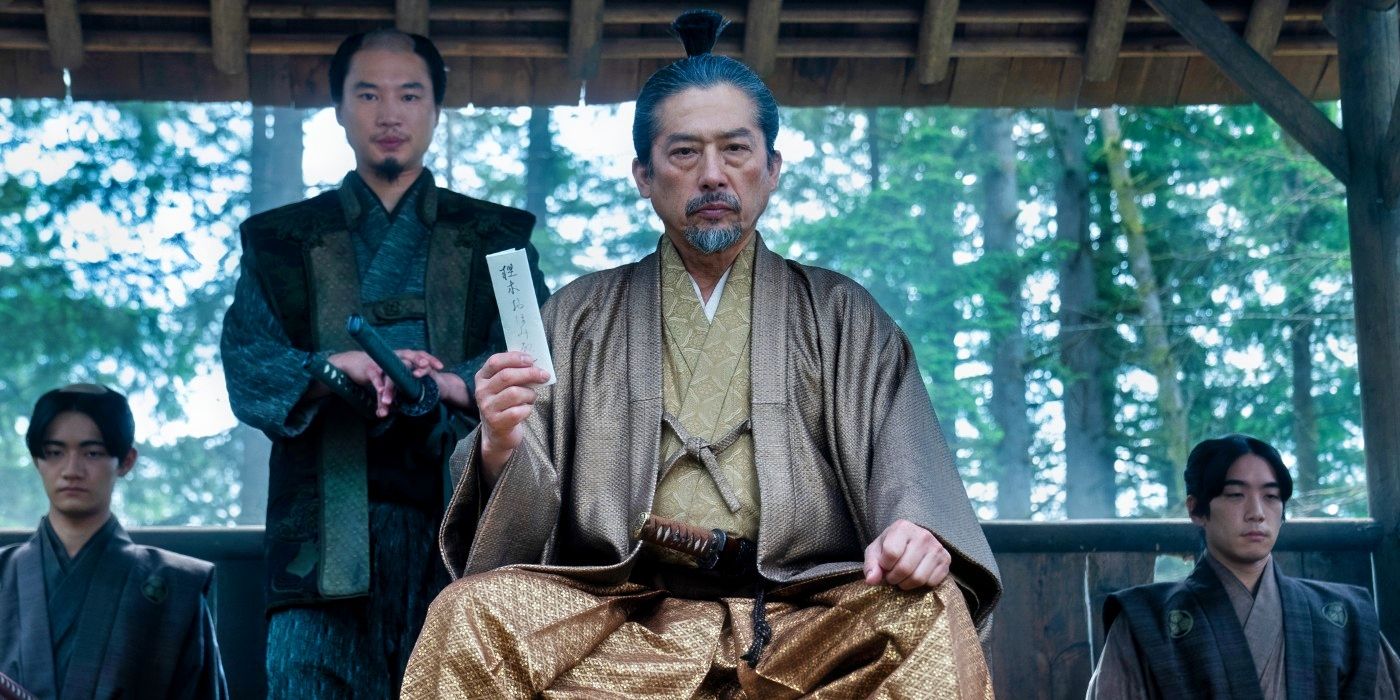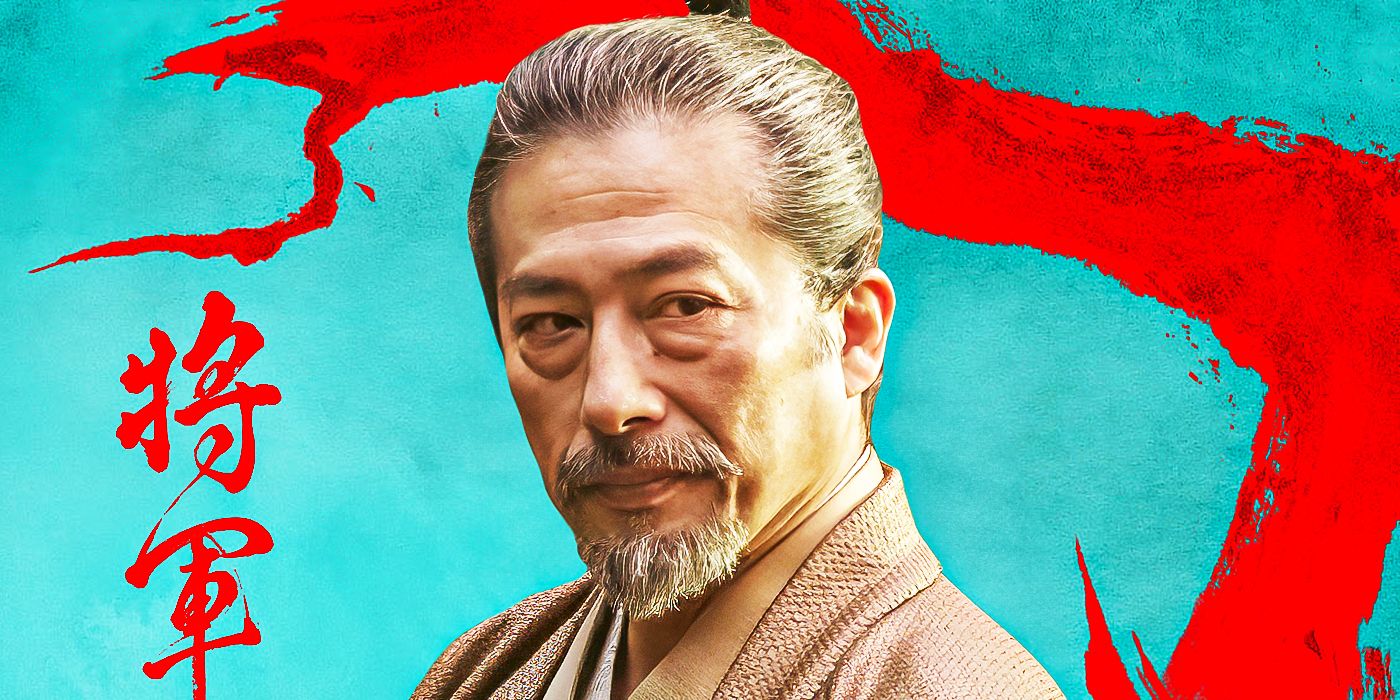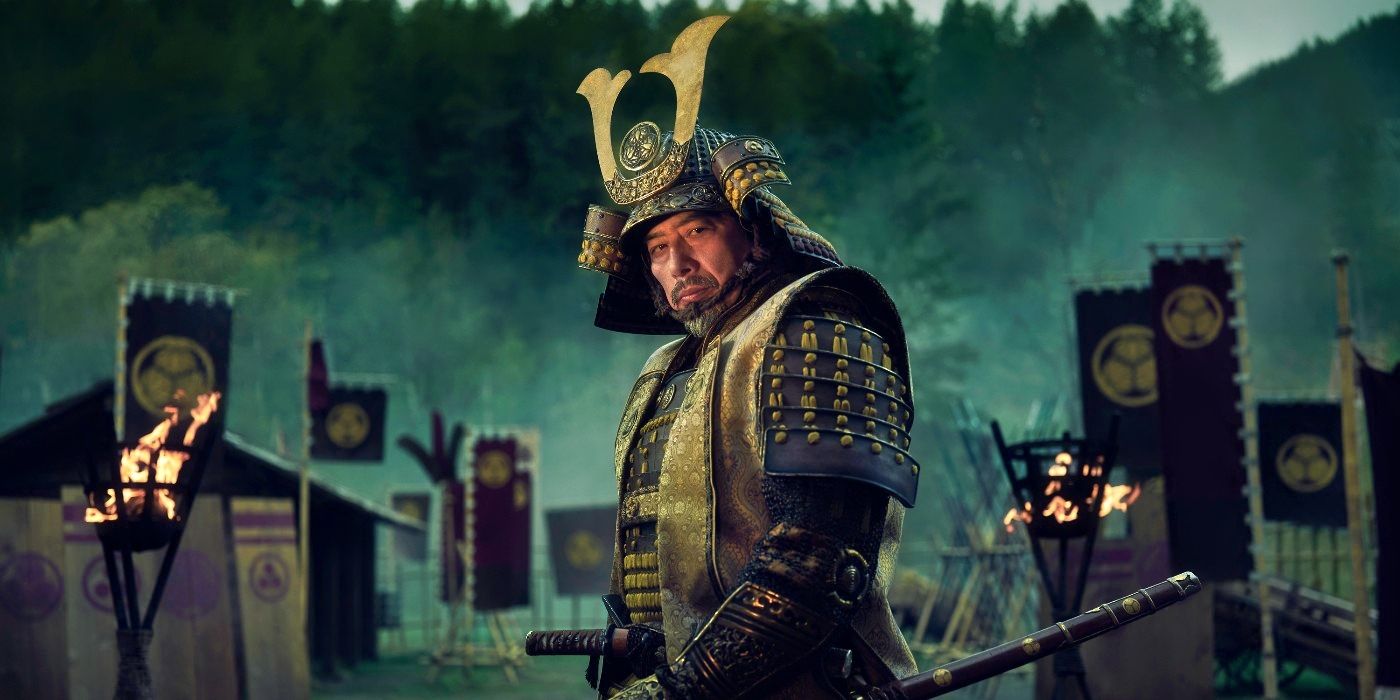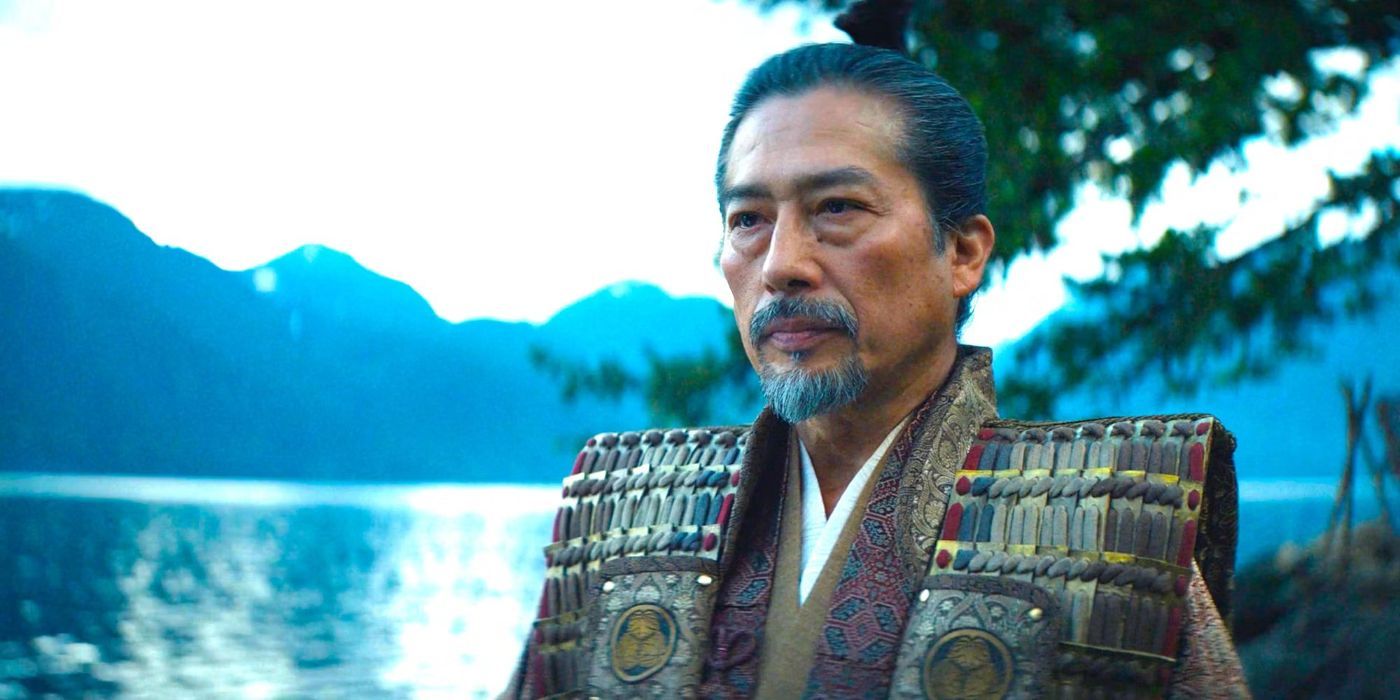The Big Picture
-
Shōgun
‘s attention to detail, reflecting the Sengoku period, engages viewers with the characters’ transformations. - Carlos Rosario’s research and creative process behind
Shōgun
‘s costumes bring depth to character arcs and historical accuracy. - Detailed costume designs, including over 2,300 pieces, subtly symbolize emotional arcs and power dynamics within the feudal Japan setting.
When FX’s Shōgun first premiered, viewers were immediately plunged into the world of feudal Japan, as wayward navigator John Blackthorne (Cosmo Jarvis) finds himself a captive, and eventual ally, of the powerful lord Yoshii Toranaga (Hiroyuki Sanada). With political tensions in the country currently simmering as a Council of Regents rules Japan in the wake of their Taikō‘s death, the question is whether one of them will make a grab for power before his young heir officially comes of age. While Toranaga has personally made it his mission to protect the Taikō‘s son, he may also have to vanquish more than one foe — both within the Council and without. Keeping Blackthorne, as well as the translator Lady Toda Mariko (Anna Sawai), close at hand could also give Toranaga the critical advantage he needs over his enemies.
Shōgun‘s ability to immerse the audience in its world wouldn’t have been possible without the production’s insistence on authenticity and accuracy, with co-creators Rachel Kondo and Justin Marks leading the charge alongside the series’ production team, consisting of both American and Japanese crew members. In addition to adhering to the mannerisms and customs of the era, the show’s characters needed to accurately represent the aesthetic of the Sengoku period in which the story is set. Enter costume designer Carlos Rosario, who sat down with Collider in the wake of Shōgun‘s record-breaking 25 Emmy nominations (including Outstanding Period Costumes for a Series) to discuss the creation of the show’s award-worthy looks. Over the course of the interview, which you can read below, Rosario talks about his research process, illustrating the evolution of Blackthorne, Mariko, and Toranaga’s characters through their clothing, the total number of costumes designed for Shōgun, and more.
Costume Designer Carlos Rosario Explains His Research Process for ‘Shōgun’
COLLIDER: What kind of research did you do to capture this era of feudal Japan? Where did you start with a project as huge and all-encompassing as this?
CARLOS ROSARIO: I was in touch with an expert on this who knows a lot about the Sengoku period. His name is Frederik Cryns, and he’s a teacher at the University of Kyoto in Japan. He’s the one who really was my person to go to in order to understand the specifics of this period. What was very useful for us to understand this period and to try to design costumes that were as authentic as possible was to study the paintings of that period. We studied the patterns of the clothing, the layerings, the colors, and the meaning of the patterns. All those different aspects allowed me to design the costumes for the show.
My first step was to understand the differences between all the different ranks, and once I knew that, that really helped me to design the costumes for every character. It was mostly understanding the paintings of that period, but then I did my own research by buying a lot of books on feudal Japan, going into the archives of every single museum in the world so I could see real pieces of that period, and sometimes watching certain Japanese movies from this period just to have a reference. But it was mostly the paintings that really helped me.
Specifically, about Japanese cinema, some of our more contemporary examples, prior to a show like this, are [Akira] Kurosawa movies. Did you lean into not just looking at historical records but that era of cinema?
ROSARIO: As I was doing my research online, of course, I was always looking at certain images from certain movies, from Kurosawa, that were portraying this period, but it really wasn’t my influence. I wanted to go straight to the source by studying the paintings and looking at real pieces from that period. The thing is, those movies were directed through the eyes of a Japanese director, and the costumes were designed from the perspective of a Japanese designer. This was a very different project. Yes, my intention was to be respectful towards the Japanese culture and the Japanese aesthetic, but I needed to bring this into the Western world and find a balance between the Japanese culture and what we are used to seeing, to find a little bit of that balance so the visuals would be approachable to the Western audience, too. So yes, there are certain links between what we design and what has been designed in Japanese movies earlier on, but it wasn’t really my reference.

Related
‘Shōgun’s Creators Break Down the Finale’s Biggest Moments and Their Future Plans
They also reveal which scenes were changed from the book and what Hiroyuki Sanada contributed as a producer.
You talked about going to museums and looking in the archives. Did you have to strike a balance between making the costumes as historically accurate as possible and only having access to modern fabrics and modern techniques for making costumes? Were there times when you had to go a little more old-school in recreating?
ROSARIO: Justin Marks, our showrunner, was very specific about wanting the show to look as accurate as possible. When I had my first three interviews with him, I think he repeated the word “authentic” a million times. That was the intention. Down the line, he also told me that we needed to know this period as much as possible, but if we needed to play outside the boundaries of this period to tell the story, we could. It worked to my advantage in terms of costumes, because when you’re telling a story, it’s not just about being authentic to the period; you have to take into consideration a lot of other things, specifically considering that we had to design thousands of costumes. You need to cut the corners here and there.
In that regard, I needed to integrate within the designs, also, the emotional arc of the characters. That’s where it becomes a little bit more artistic, creative, and sometimes poetic, where you try to incorporate symbols that allow you to tell the story of where the character is in one specific scene. When you’re designing shows of this magnitude at this moment, and you have to design thousands and thousands of costumes within a very short amount of time, you have to choose your battles. Yes, it is about being as authentic as possible, but you need to integrate other aspects that are going to allow you to be successful in telling the story of your characters.
How many total costumes were made for the show, including background extras?
ROSARIO: We made more than 2,300 costumes — made. We did rent about 1,000 pieces from Japan, which also allowed us to put together all those different outfits for the background. We also made a lot of the costumes for the background and different countries in the world, and the armors were made outside of Canada. But yes, we made more than 2,300 costumes — made them. A lot of people these days in shows say, “We made.” No, you rented pieces, and then you created the costumes. We actually made the pieces. Then, on top of that, we played with certain rental pieces that we got out of Japan.
‘Shōgun’s Costume Designer Explains the Evolution of Looks for Blackthorne, Mariko, and Toranaga
Blackthorne is among the characters who undergo the biggest transformation, not just in terms of his mindset and his change in thinking towards Japan and its people, but also what we see him wearing. What was the brief that you got about what was important to illustrate about him and his evolution through the costumes?
ROSARIO: Our three lead characters, Blackthorne, Toranaga, and Mariko, have their own emotional arc, and the three of them are portrayed through the costumes in very different ways. For Blackthorne, it was very clear to me that once he removes his first outfit, his sailor outfit, it’s almost like removing his own identity. They impose on him wearing that first kosode that he wears, that dark burgundy kosode. For me, that was really important because it was his first introduction to the Japanese culture, wearing something so classic and typical. That was a very healthy start for me in terms of designing the costumes for him, because it was almost like a very basic white canvas.
Then, as he’s introduced into the Japanese culture, and he starts understanding where he fits within the dynamics of all the other characters, I started adding more and more Japanese pieces to his costumes. Slowly, as he has to wear those different pieces, I really felt that almost his way of speaking and his movements changed. So, we go from that basic kosode all the way to that formal Kataginu, the green Kataginu with the gold stripes, which is the most formal outfit that he wears throughout the show. His evolution through the costumes was mostly about adding all these very classic Japanese pieces to his wardrobe.
Usually, when you work on TV, you create a closet, and then you start pulling all those different pieces, and you can play with them throughout 10 episodes. What was complicated about Shōgun is that all these different characters from different ranks are facing different circumstances, and they all have their own emotional arc, they’re all a different storyline, and they’re going to all these different locations. So, for every single episode, it felt like we had to start from the beginning. That was the complication of this project.
With Mariko, it felt like she started in a very soft place with subtle colors, and then gradually we see bolder prints on her. At one point, she wears this black and gold flowered piece, and it was so striking on her. What was the intention of starting with her in that understated place, and then, as she starts to find her voice in the show, having that reflected in her wardrobe?
ROSARIO: You beautifully said it. That defines exactly the evolution of her costumes. To me, Mariko was the heart of the project. There is no doubt about it. I really wanted her costumes to not only reflect the authenticity of the period but also her emotional arc. I would say her costumes, more than any of the characters on Shōgun, the creative force behind her costumes, are definitely her emotional evolution and empowerment from a character that starts out being completely empty, almost dead inside, because of what happened to her family from being dishonored for what her father did, trying to kill a very powerful lord. So her father had to commit seppuku, and his entire family also had to do the same thing. The only one who was able to survive was actually Mariko because she was married to Buntaro, but every year, during the anniversary of the death of her family, she begged Buntaro to be able to commit seppuku, and she wasn’t able to do that. He didn’t authorize that.
Basically, she starts from a place of being completely dead inside, and I wanted her costumes to reflect that. That’s why, in the beginning, there is this monochromatic color palette that represents winter and death, and it represents branches without leaves. Then slowly, as she finds her voice and starts empowering herself, she meets Blackthorne, and she starts feeling that connection with him, and she’s given that path of being the translator between Toranaga and Blackthorne, I felt like slowly I had to find a way to bring more life into her costumes.
What I used to do that was by painting camellias on her costumes. Slowly, you see that her costumes are bolder, bigger patterns, they feel more grounded, they feel more present. Slowly, the red is amplified, the gold is amplified, and I started adding a lot of symbols that were not necessarily part of that period in the sense that grays were not painted on uchikakes and kosodes, butterflies were not embroidered onto the fabrics. But to me, it represented where Mariko was at that moment, that sense of transformation, that sense of taking off and finding her own voice. So, it was authentic in the sense that the patterns were very bold at that period, and the colors were very vibrant, but for me, it was mostly to incorporate where she was at emotionally.

Related
Hiroyuki Sanada Came Up With ‘Shōgun’s Stunning Final Shot
The actor and producer compares his own journey on the show to Toranaga’s, where and when he decided to show more emotion, and more.
For Toranaga, it feels like as the show is ramping up toward the war, his clothes start to become more militaristic. He feels a bit more like a commander making a statement about his authority. Was that something that you wanted to be conscious of — incorporating elements like armor, but also making it lightweight and easy for the actors to wear in these big moments?
ROSARIO: Absolutely, because I knew those actors were going to be wearing that armor for long, long hours and days and days at a time. It was very important for me as a costume designer to take that into consideration. I chose to incorporate a lot of leather pieces into the armor because I felt like it was more in alignment with the Sengoku period, as opposed to the Edo period, which was originally made out of metal and more shiny. I wanted something that felt more raw, more connected to nature, something that would feel more textual, too. By using leather, I was able to break down the armor much more beautifully and give some depth to the texture, to the fabric. So yes, they were very light.
At one of the first fittings with Sanada-san, he said that that was the lightest armor he had ever worn in his career. That was great because once you dress one of those samurais with those armors, they’re so heavy that there is no way they’re going to take them off to go to the bathroom, so you need to make them really light so they can actually wear them throughout the day. It actually takes about two or three people to dress one of those samurais for 45 minutes, so it was good to just help them feel comfortable with it.
‘Shōgun’s Carlos Rosario Reveals Costume Easter Eggs for Mariko and Ochiba
You mentioned painting things on Mariko’s kosode that don’t normally appear in that period. Are there any other secret details you put into different costumes — either just for you or something you wanted viewers to pick up on that they wouldn’t notice the first time?
ROSARIO: We created a lot of the textiles for that show, so we did paint a lot of them, and we studied the patterns of that period because everything meant something. Speaking of the meaning of patterns that the audience wouldn’t necessarily know, the first uchikake that she wears kind of curves, right? That actually comes from a piece that really inspired me from that period. I was working with this incredible textile artist who did all the fabrics for Memoirs of a Geisha and The Last Samurai, and we designed that pattern. What that pattern means is the snow covering the grass, which was very much in alignment with who Mariko was at that moment. It was sort of death, it was trying to mask life, and I thought it was very appropriate to start with that. We did that as we were creating all the textiles for the show.
There is another one that I really love that nobody would know by watching the show. It’s one of the uchikakes that Lady Ochiba is wearing towards the end of Episode 8 or 9, this beautiful purple uchikake with the fans. I had to design that outfit really fast, it was the end of the day, and I was like, “Oh my god, I need to give the instructions to all of my team the following morning. What am I going to do?” I went to the workshop and it was empty. I looked under the tables and I saw we had all these boxes and plastic bags with all the scraps of all the fabrics of the uchikakes of all the other noble ladies from Osaka. I took them, cut them into fans, and applied them to the uchikake of Ochiba. It’s very meaningful and beautiful because Ochiba, who is of the highest rank in Osaka, is actually wearing a costume that incorporates the fabrics of all the other noble ladies. In a way, it shows her superiority over everybody else.
Are there any specific looks that were more challenging to figure out, anything that went through a few different versions before you settled on what ends up in the show?
ROSARIO: No, actually. With this show, we didn’t have much time to design. [Laughs] I had less than five months — I started really late. As a matter of fact, most of my team started two months before shooting, so it was pretty fast and furious. So, to be honest with you, I only had time to have one fitting per costume for every actor. For Sanada-san and some of our lead characters, I was able to check fitting for certain costumes, but mostly whatever you see on screen was one fitting. There was no backup. There was no time because when you need two or three people to dress that person for 45 minutes, you have one hour to do the fitting, you do that fitting, and then you move on to another actor.
Was there anything that was a little bit more challenging in terms of figuring out a definitive look?
ROSARIO: The armors were complicated because that’s something that I’ve never done before. It’s complicated to design the armor, not just from the practical and functional aspects of it, but also from the aesthetic part of it. Also, you don’t really see too much, but we had to design different armor for every different rank, plus a completely different armor for the lord. That was a lot of work, and that needed to be done within the first two months because we needed to send them to be made, and I wanted to give our manufacturing companies as much time as possible. I was working with five illustrators working around the clock doing all the drawings, understanding how those armors work, and then going through the approval process.
It’s mostly the subtleties of the language of the clothing of that period and understanding that, for every single rank, you have something different. When you look at Japanese culture, and you look at the female silhouettes and the male silhouettes, it feels very simple. There are three or four silhouettes, but then you go into all the complexities of every different rank, and everything has a meaning.
Carlos Rosario Reveals His Favorite ‘Shōgun’ Costume
What’s your personal favorite overall piece that ended up in the show — either because the process was so intensive, and you’re proud of what you were able to ultimately conceive and craft, or because you have a personal attachment to it?
ROSARIO: I’m really proud of the last jinbaori that Toranaga is wearing, which you spoke a little bit about earlier. As his storyline progresses, it’s true that his costumes become more militaristic. I knew that I needed a really strong piece to finish the show, and that one came up by doing some research. I felt that he needed something that would make him look extremely powerful and authoritarian in a way, and when I was doing all my research, I actually found all these different types of jinbaori that were designed as armor pieces. That was after 10 episodes, and I was like, “I’ve never designed a jinbaori that incorporated those techniques.” It was mostly techniques of the lacing for the armor and the underlayers, but never for the top layer. I thought it was interesting because he never wore that jinbaori on top of his armor, he always wore it on top of his uniform, and I love the contrast between the softness of his uniform and the rigidity of that jinbaori.
To me, it really represented who Toranaga was. There was a very wise man behind it, but very authoritarian and powerful. He knew where he was going, he knew exactly what he needed to focus on in order to get to the Sekigahara battle and not even have to fight. He was a very wise man, so I wanted to have something that would reflect the mixture of his power, his strength, but also his vulnerability. That piece is artistically a complicated piece to create because we incorporated all these different pieces of leather and wood that we cut by hand, and then all of them were laced with different coatings, and then everything was painted and broken down. It took three or four people three or four weeks to do by hand. It was a complicated piece, for sure.
Shōgun is available to stream on Hulu in the U.S.
Watch on Hulu






